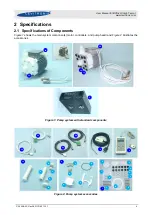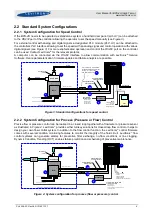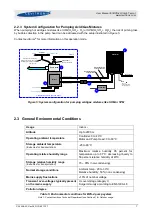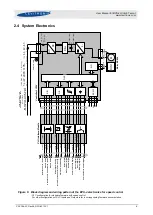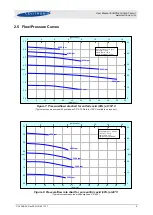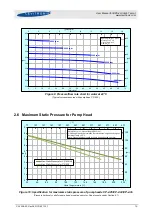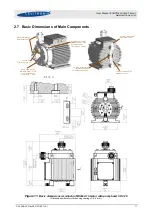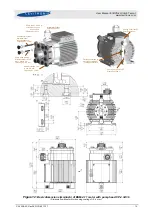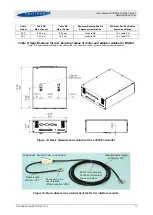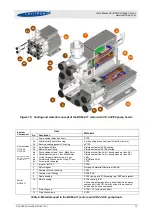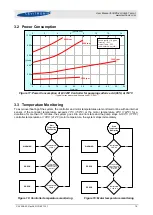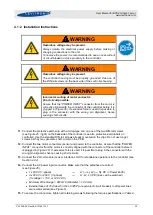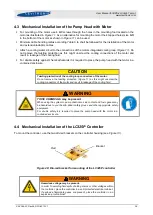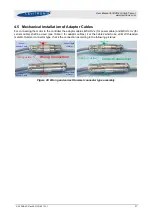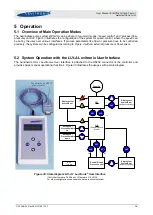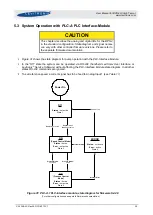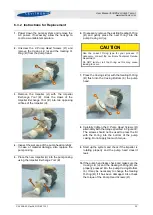
User Manual for BPS-4H (High Temp.)
www.levitronix.com
PL-2009-03, Rev04, DCO# 21-101
18
The above curves are temperature measurements of inside the motor at certain pump liquid, cooling liquid and
ambient temperatures. Equation
shows how to calculate the motor temperature for other liquid and
ambient temperatures based on these curves. The ambient temperature has a very low influence on the
temperature inside the motor, which is mainly influenced by the temperature of the cooling liquid.
𝑇
𝑀
(
𝑇
𝑃𝐿
𝑇
𝐶𝐿
) ≈ 𝑇
𝑀
(𝑇
𝑃𝐿
= 150°𝐶, 𝑇
𝐶𝐿
= 17°𝐶)
⏟
𝑠𝑒𝑒 𝐹𝑖𝑔𝑢𝑟𝑒 21
+ (𝑇
𝑃𝐿
− 150°𝐶) ∙ 𝑡𝑔
𝐿𝑀
+ (𝑇
𝐶𝐿
− 17°𝐶)
𝑇
𝑀
= 𝑀𝑜𝑡𝑜𝑟 𝑡𝑒𝑚𝑝𝑒𝑟𝑎𝑡𝑢𝑟𝑒
𝑇
𝐶𝐿
= 𝐶𝑜𝑜𝑙𝑖𝑛𝑔 𝑙𝑖𝑞𝑢𝑖𝑑 𝑡𝑒𝑚𝑝𝑒𝑟𝑎𝑡𝑢𝑟𝑒
𝑇
𝑃𝐿
= 𝑃𝑢𝑚𝑝 𝑙𝑖𝑞𝑢𝑖𝑑 𝑡𝑒𝑚𝑝𝑒𝑟𝑎𝑡𝑢𝑟𝑒
𝑡𝑔
𝐿𝑀
= 𝑇𝑒𝑚𝑝𝑒𝑟𝑎𝑡𝑢𝑟𝑒 𝑔𝑟𝑎𝑑𝑖𝑒𝑛𝑡 𝑙𝑖𝑞𝑢𝑖𝑑/𝑚𝑜𝑡𝑜𝑟 = 0.07
(Eq. 1)
All above presented thermal data are typical values, which are partly based on measurements and partly on
interpolations with a simplified thermal model and are therefore only guideline values and are suitable for a
first layout of the basic thermal concept. It is recommended to check the thermal values with the motor placed
on the final location and under worst case performance conditions of the application.
In order to account for thermal variations (like ambient temperature, closed chemical cabinets or corners
without ventilations) and to not significantly reduce the MTBF of the motor it is recommended to keep about
20°C
safety distance to the absolute thermal limit of the motor (
90°C
) when designing and testing the thermal
concept of the pump system.
CAUTION
Use motor cooling loop.
Specifically, when pumping liquids at temperatures higher than 90°C the water
cooling loop of the motor has to be active even if the pump is not running
otherwise components inside the motor might be destroyed. For example, after
an emergency stop or power failure, it must be assured that water cooling is still
active until the hot liquid in the pump has cooled down.
The cooling liquid temperature shall not be higher than 25°C. Recommended is
a range of 10
– 17°C.

